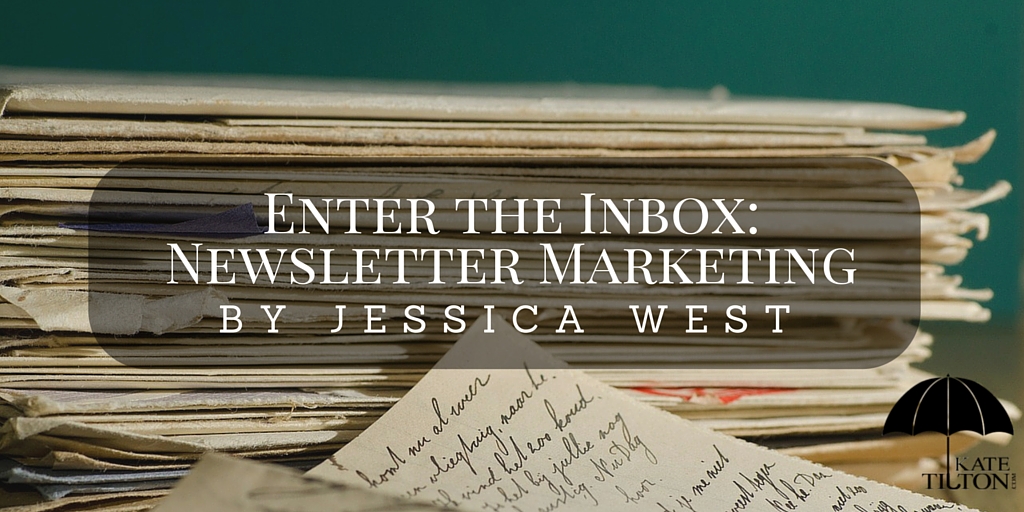
If you’ve been checking out my posts here at Kate Tilton, Connecting Authors & Readers over the last few months, you’ll notice a theme. This is the fifth and final article in a series meant to help authors achieve success by establishing the basic building blocks of publishing books. While my articles have been geared toward authors, the same underlying principles can be applied to various industries. All the advice I’m giving you I’ve either learned the hard way or watched someone else do so. If you take nothing else away from all of these articles, remember this: if you don’t know how to use the tools of your trade effectively, they won’t be helpful at all.
Promise
What you hope to accomplish with your newsletter isn’t the same as what readers want to sign up for. You’re selling books (or products/services). That, in and of itself, isn’t something people necessarily care about. See your newsletter for what it is: an e-mail to a potential reader. If you’re a writer, you should be good at dialoguing. So sit down with your ideal imaginary reader and have a conversation. By ideal, I don’t mean, “OMG I lurve your writing and wants to buy all ur books!!!” Those are rare if you meet them at all. No, by your ideal reader, I mean: who is the person who wants what you’re offering? If you write travel books, your reader would be someone who loves to travel. If you write YA fantasy books, your target audience (see also; ideal reader) is someone who loves to read them. Do some research and find out who your target audience is. Who wants what you’ve got? When you have a good idea of who that person (or type of person) is, have a “dialogue” with them. Ask them what they want from you. You have the answers, you just need to open yourself to hearing them. When you do, make a list of “promises” to your ideal reader and make sure each e-mail (newsletter) you write delivers on those promises, or at least one of those promises, in each e-mail.
Purpose
Naturally, you do want your newsletter to work for you, to achieve specific goals, to help you succeed. Compromise is your best friend. Make a list of things you hope to accomplish with your newsletter. Selling books (or other products/services) shouldn’t be the only thing on that list. Gaining new subscribers to your newsletter should be the first priority. So make sure every newsletter includes an opportunity for recipients to share, as well as gentle encouragement to do so. Include a brief “ad” for your newest release, or remind newsletter subscribers that you have a book out that might interest them (assuming you do). Your newsletter can also act as an invitation. If you’re offering a giveaway or have an event coming up, let your subscribers know. But remember to keep your promises. Check your list of promises to see if there’s something else you can compromise on. You might, for example, promise to include a helpful resource in each e-mail. Look for affiliate opportunities to make that promise fulfillment serve a purpose for you. That’s compromise. You give and you ask.
Numbers
Even if you’ve done everything right, you’ll have to accept some hard truths. Signing up for a newsletter requires very little commitment on the recipient’s part. That’s good, you want your e-mails to be a reward in exchange for very little effort. The downside is that the purpose is a bit harder to achieve. You give and you ask, but you will receive only a percentage of what you hope for. That’s the key to everything, not just newsletters. It’s all about the numbers. According to Mailchimp, the average open rate for the Media and Publishing Industry is 22.6%. Of those who open your e-mails, only 4.69% will click a link contained therein. Maybe 1% of your mailing list will actually buy your new book and, unfortunately, that’s a reasonable estimation. If you have 100 subscribers, that’s only 1 person. If you have 1,000, it’s 10. If you write, rewrite, revise, edit, and publish a book every month, consistently, sell that book for $4.99 at a 70% royalty rate, and have 1,000 subscribers, 10 of whom buy your book every month, then you’re doing pretty good as an independent author. And that’s making about $35 a month. If that sounds dismal and hopeless, you’re forgetting something it’s imperative you not forget.
Value
Is it worth it to have a newsletter? Yes, absolutely. Do Not Forget: Those e-mails are a part of a larger machine that performs best when all parts are in good working order. Will your car run on an engine alone? No. That’s why you can’t sell books without blogging, social media, marketing, and newsletters. Your book isn’t the whole car, it’s the chassis. Publishing your book adds an engine to the frame, but even that’s not enough to make that book take off. You still need a transmission, battery, axle, exhaust system, fuel system, and electronics to make that car run well and properly. (Generously apply social media and blogging as metaphors.) And if you really want to get fancy, you add in a sweet audio system, a navigation system, a suspension kit, and maybe even turbo that bad boy. I’m talking about marketing, here, but beyond ads and events. Book trailers and “swag” are examples of extras you might add to the basics so that your book isn’t stuck at factory default. Each step in the process has value, but only if it works in conjunction with the whole.
Review all the articles in this series and make a plan that works for you. Make lists, dream big, work hard, and don’t give up on any of the parts that make your book take off. Don’t settle for good enough, for the factory settings, tweak that baby until it simply cannot be ignored. Watch an episode of Pimp My Ride and really dig into that metaphor. You’ll see what I’m talking about. Give your entire platform some panache. As my favorite villain put so well, “It’s all about PRESENTATION!” (BONUS: Free e-book of your choice, up to a $5 value, to the first person who comments on this post with the name of said villain.)
Read up on the series:
- ENTER THE BLOGOSPHERE
- ENTER THE SOCIAL MEDIA SCENE
- ENTER MARKETING MAYHEM
- ENTER THE PUBLISHING INDUSTRY
Coming next month … Book Critique ABCEs, wherein I’ll answer the following questions, and then some.
- What’s the difference between a beta reader and a critique partner?
- When is your book ready for an editor?
- Do you need a proofreader even after you’ve hired an editor?
- How do you know when you’ve done all you can and your book is ready to publish?


Leave a Reply